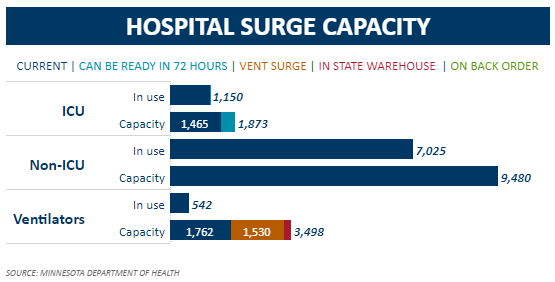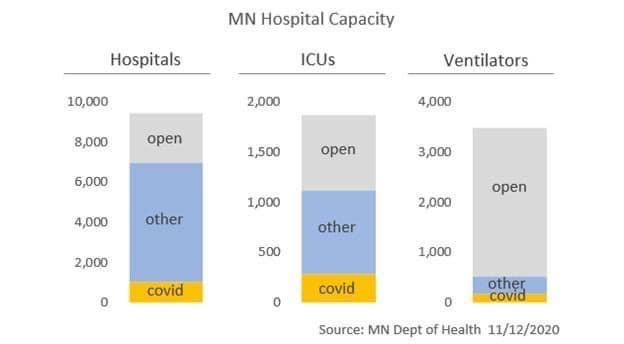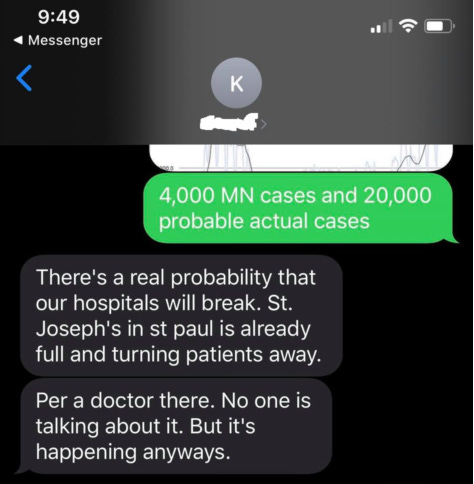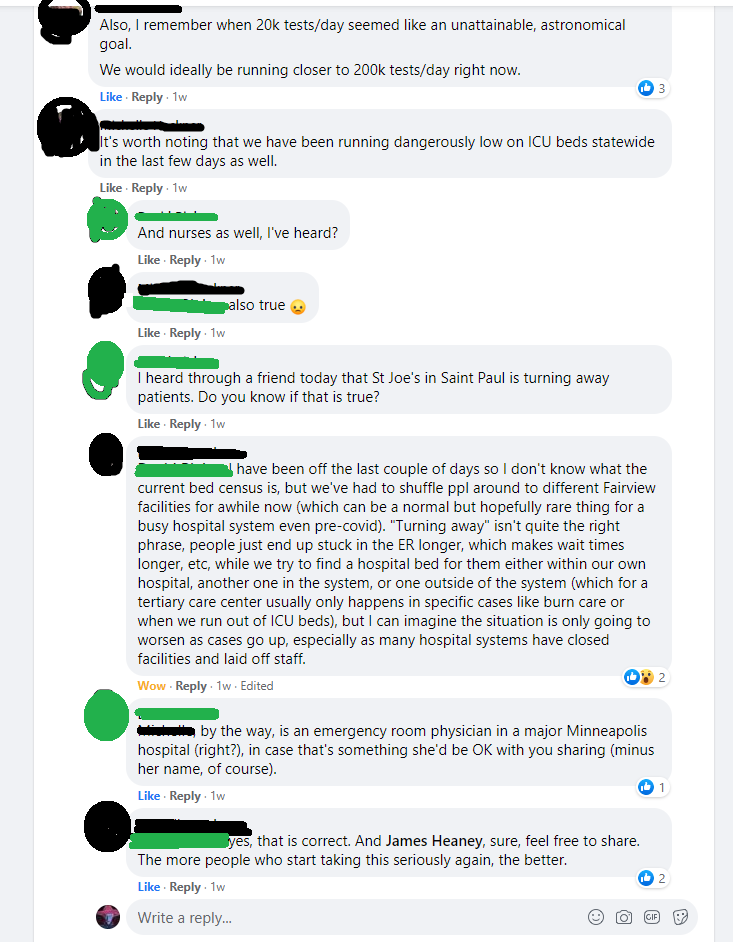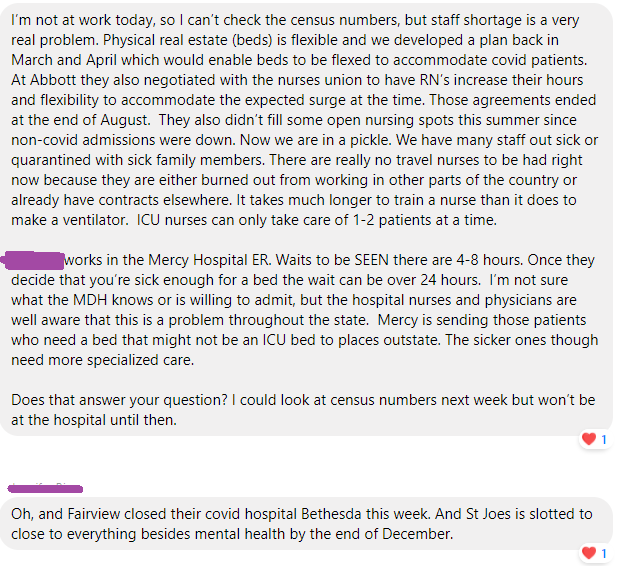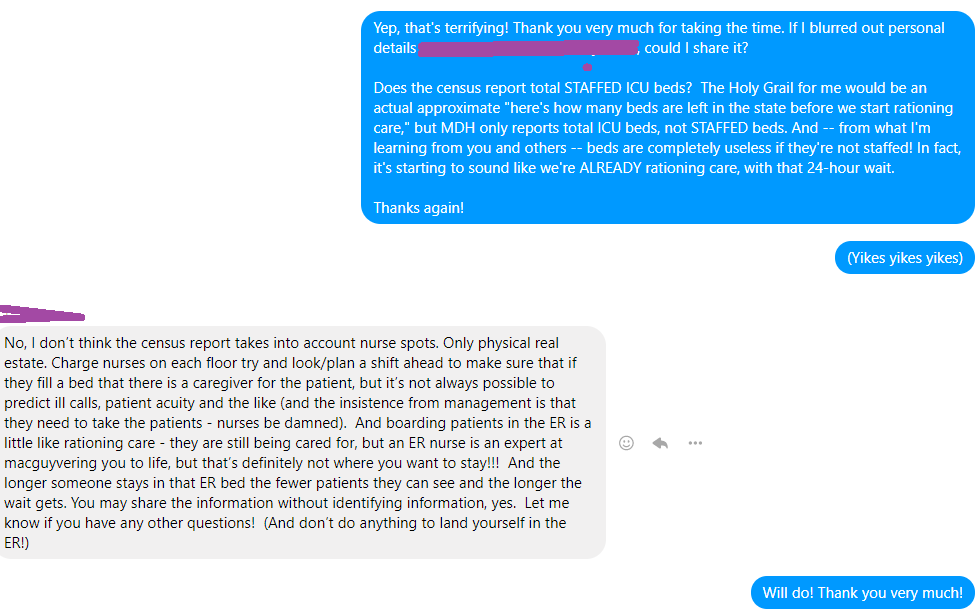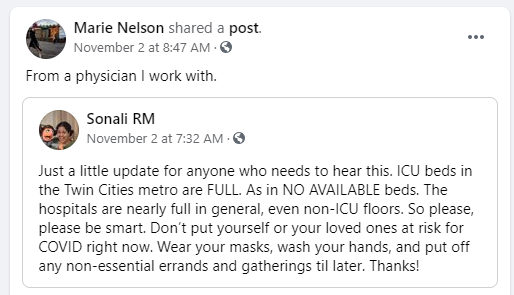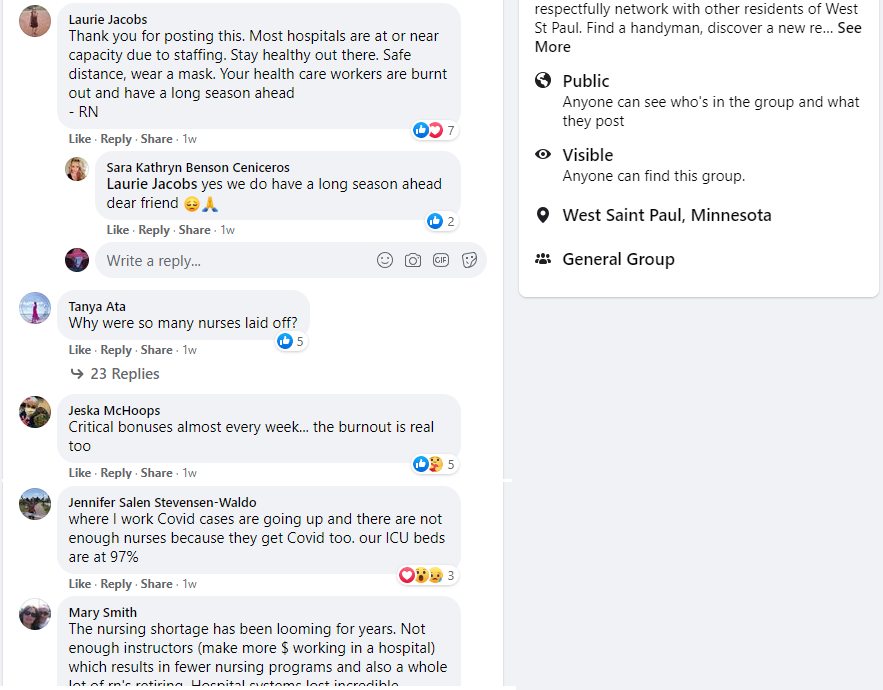Some of Minnesota's ICU Beds are a Mirage (and that's Very Very Bad)
If you look at the Minnesota Department of Health's hospital capacity stats today, they don't look that bad.
There's an even more soothing version of this data circulating on certain Minnesota-centric Facebook groups:
Ordinary ICU bed usage (in non-covid times) is like 850, and we're at 1150... but we have 1450 beds and an extra 400 available for a surge. So we're okay, right? We're pushing up toward capacity but still have a looooooooong way to go before we get there. Right?
Not right. I've been posting these MDH hospital capacity stats regularly for months in my weather reports, but, over the past two weeks, I started to hear various kinds of pushback from various friends (or friends of friends) who work in hospitals. They're telling me that, sure, the beds exist, MDH is right enough about that... but we're nearly out of medical staff.
The problem is obvious: If you dump a critically ill covid patient (or a heart attack patient, or a car crash victim) into an ICU bed, but can't provide that patient with an ICU doctor and an ICU nurse, then the patient may as well be dying in his own bed at home, for all the good the ICU will do him. ICU beds that can't be staffed might as well not exist, and, on our present course, we will exhaust our hospital staff capacity well before we fill all the physical beds.
You may have seen similar reports in the papers. However, you may not trust the media (I largely don't!), so here are some conversations with I've had or seen with real people who work in hospitals. The picture they paint is more dire than the MDH stats:
Another:
Another:
Another:
More from the same person:
This one is public, part of a local Neighbors group I'm part of:
From the comments on a similar post in the same group:
Bottom line: We are running out of hospital beds.
We don't know how close we are to the edge. Nobody seems to have that information. It varies too much day-to-day, even hour-to-hour. Hospital censuses don't seem to be configured right now to report actual, staffed capacity. So we are flying blind here. But we know that we are getting there. We know that the comforting hospital capacity charts I've been publishing for the past many months (based on state data) have been misleading about our real limits. We just don't know how misleading.
We know that we are demanding too much of our nurses and doctors, that the burnout from this year has already caused lasting damage to the medical field. We know that cases are so widespread right now that even if we stopped all transmission tomorrow using magic, we would have to demand still more of our nurses and doctors as cases already transmitted but still incubating blossom into hospitalizations. In reality, we have at least another month before a vaccine gets here for high-risk people (and the vaccine requires two shots over 21 days, so more like two months).
There is no help coming from out-of-state. They're all dealing with their own corona surges. There's no help coming from Europe; the exact same thing is happening there, seemingly regardless of government policy. The virus remains on an exponential growth curve well into our latest surge, although the burden on hospitals has (thankfully) grown only linearly.
We all know what happens if they do run out of beds -- and there are more and more reasons to think we will reach that point before the vaccine arrives.
What should we do?
Zeynep Tufecki has been one of the few people to get this epidemic more or less right all along: she raised the alarm about the pandemic early, she was an advocate for masks back when people were treated as insane and anti-science for supporting masks, she's called out public health institutions for hypocrisy (which I've also written about), she's correctly said for months that beaches are a pretty safe place and we're insane to shame Florida for having open beaches, and she's worked very hard to explain covid's transmission dynamics for a popular audience.
And she's now saying that it's time to hunker down:
I take no joy in saying this, but all of this means that any gathering outside one’s existing quarantine pod should be avoided for now—especially if it is indoors. Think of it as a postponement and plan to hold it later. Better a late Christmas than an early medical catastrophe. Pods should not expand unless absolutely necessary. Order takeout instead of dining indoors. Make game night virtual. Shop in bulk, so you can do fewer trips to the store. It’s not the right time for wedding receptions or birthday parties.
I have a ten-person "quarantine pod" right now, which includes three households. We see each other a couple times a week for the sake of human contact, and this is very good. (All of us otherwise work from home and have no other personal contact with others except while grocery shopping.) We still get together online for game nights or movie watch parties. (Among Us really is a perfect game to play with a big group of friends during a plague year.) My D&D group has been online for months now; roll20.net is a great complement to a Zoom call if you're trying to figure out how to do that yourself.
States may not impose formal stay-at-home orders again -- and they probably shouldn't, since the last round of lockdowns was ineffective and Congress can't get its act together on a relief package -- but I agree with her: in Minnesota, it's time to start living as if you are under a stay-at-home order again. Not just to avoid covid, either: at this point, you really want to avoid getting sick with anything, or getting into any kind of accident.
Because there might not be a hospital bed for you if you do.
PROGRAMMING NOTE: I plan to discontinue my regular "Minnesota Covid Wearther Report" series this week. This is because David Montgomery, an MPR data reporter who charts most of the same figures as I do, is starting a newsletter, which will release similar charts on a daily basis (my series has been much less frequent). My series still offers one or two unique things, but not enough to be worth continuing. I'm signing up for Montgomery's newsletter, and I suggest you do the same. (However, I may do one final report this week, just to close it out, and also to see exactly how high my Actual Case Estimates are going to go.)



